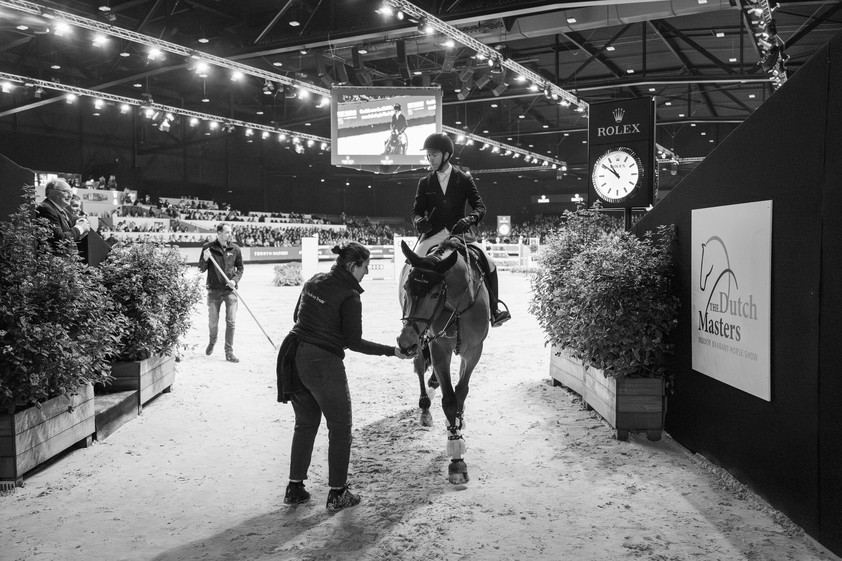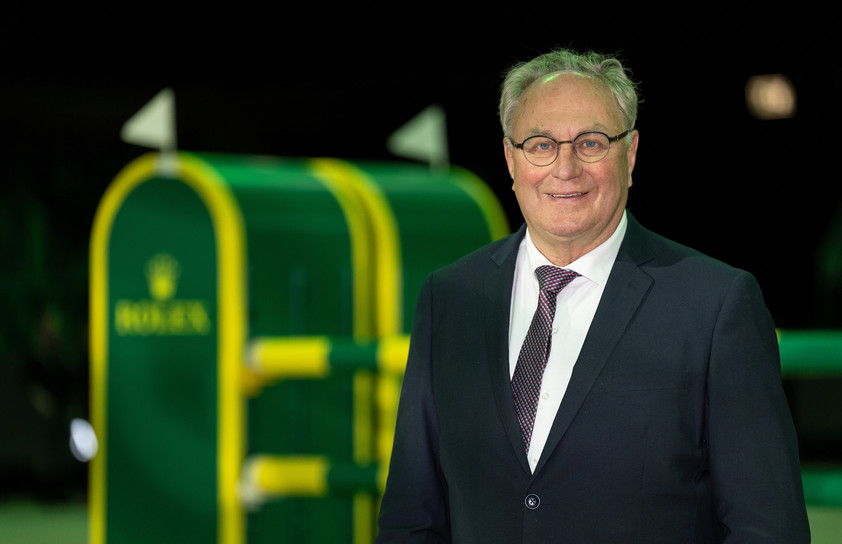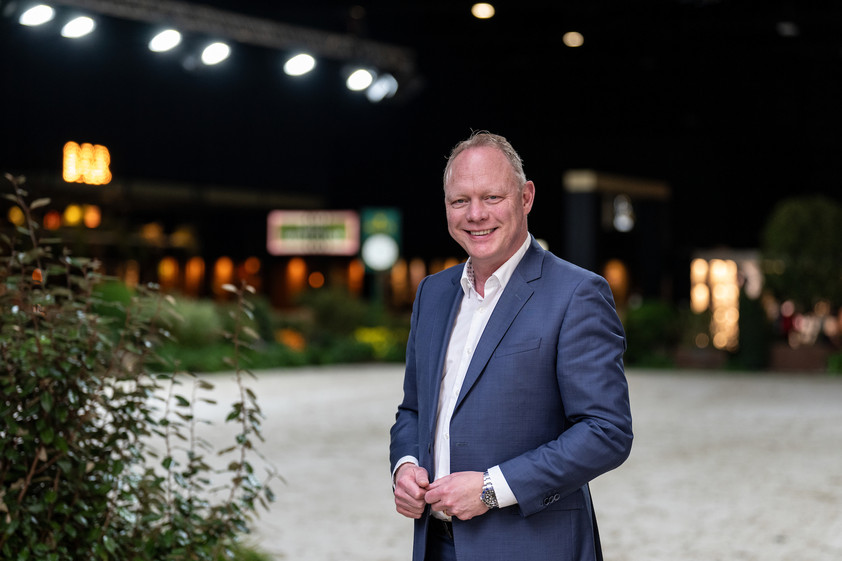Friday marked the first day of international show jumping at this year’s edition of The Dutch Masters with the pinnacle class coming from the VDL Groep Prize. Held under the bright lights of the Brabanthallen, the world’s best horse and rider combinations gathered to take on Louis Konickx’s technically designed 1.55m course.
Fittingly, the first of the 42 riders to enter the arena was the long-standing World No.1 Henrik von Eckermann with his sensational gelding King Edward. The pair who are the reigning FEI World Champions could not quite produce the round that they wanted when collecting four faults.
Rolex Testimonee and third into the arena, Bertram Allen, was the first rider to produce a clear round and set the standard for those to follow. This was quickly followed, much to the delight of the home crowd, by Dutch rider Frank Schuttert, who ensured that there would be a jump-off. Clears came throughout the talented field, including FEI European Champions Steve Guerdat and Dynamix de Belheme, as well as fellow Rolex Testimonee, Daniel Deusser – a three-time winner of the Rolex Grand Prix at the venue – who once again showed himself to be a true expert of the main arena at this prestigious show with a stylish clear round.
In total 11 riders proceeded through to the jump-off, a list that included the Rolex Grand Slam of Show Jumping live contender Richard Vogel and the two Rolex Young Rider Academy riders Robert Murphy and Lars Kersten.
After a short break, riders entered the arena in reverse order of merit, based on their time from the first round, with the quickest clear round having the advantage of being the last to go. First into the arena, Deusser set the early pace with a clear in a time of 44.73 seconds, but it wasn’t to be for the German rider, as Guerdat produced a smooth and nimble round to come home 2.08 seconds faster. The crowds then came alive just one horse later as Maikel van der Vleuten took 0.61 seconds of the Swiss rider’s time. None of the remaining riders could match the precision, skill, and accuracy showed by van der Vleuten, leaving the Dutchman to claim the 2024 VDL Groep Prize.
Speaking on his win van der Vleuten remarked: “My horse [Beauville Z N.O.P.] was incredible today – it was his first show in two and a half months so I am very pleased with this result. He jumped a lot better in the jump-off which meant I could get all of the forward strides which enabled me to beat Steve’s [Guerdat] time. We will see how he feels in the next few days but the plan is to jump him in the Rolex Grand Prix on Sunday.”
The home favourite added: “The world’s best riders in the world are here not only to compete but to win. As a Dutch rider this show is so special to me and the crowds here are amazing. They were a fantastic support for me this evening, so to win in front of them is truly incredible.”
For you, why is The Dutch Masters such a special show?
It is an incredible show and I have so many special memories here. When I arrived here on Tuesday to lay out the poles with my team, we were in awe – the arena is so beautiful and the shopping village is amazing. In my opinion, there is no other show quite like it. As a course designer, there are very few limits here, which allows us to be very creative. Every show has a shopping village or a nice area, but the atmosphere and the energy here is just something else.
Can you tell us a little bit about the course that you have designed for Sunday’s Rolex Grand Prix?
Every year when I start designing the course for The Dutch Masters, I am filled with memories from the past years. A week or so ago, we put the planned course on paper with the correct arena dimensions. We had a beautiful course, but we soon realized that something was wrong – all of the combinations were on the right-hand side of the arena, and we could not seem to change it without ruining the course. We soon figured out a solution, and I think that this is a special course – there is a turn back which I do not think that you see in many arenas. The riders will jump a double and then do a tight turn back to another double. Quintin [Maertens], who is much more precise at measuring than me, wanted to check that this turn could actually be done, and so on Thursday we went into the main arena and tested it out to make sure that it worked – it was such a relief to know that it would work.
The first round has fourteen fences, which is quite a lot, but the same number as the CHI Geneva. There are two double combinations and one triple – the conditions here are so incredible that the horses jump so well, so it is a balance to design the perfect course. We currently have two jump-off options so need to decide which one we will use.
I think it is a great honour for the riders to be here and I think they will be excited to test their horses to see if they are the best of the best.
How important is the team around you in a successful course?
Earlier in my career, I would make my own plans and be a bit more independent. But nowadays my team is so important to me – I think that I have the best team.
Quintin [Maertens] is so intelligent and is a multi-talented man. If I have a crazy idea, he is the one that makes it fit. Then there is Gérard Lachat, who I work with here and at the CHI Geneva – he is our counterbalance and incredible at creating the perfect distances. Paul Rooijmans is the team organizer. All of our assistants have their own roles and without them this would not be able to happen.
We also have 40 volunteers, who are a club from a local riding school. They have helped us for over 15 years and they are great. We have some very good drivers moving the fences and they help us to make sure that course is presented at the highest level.
Which course are you most proud of?
I think for me the course that I am most proud of was the course in 2021 during the Covid edition of the show. As we were not allowed fans, the arena was four metres wider than usual. This meant were able to do things we had never done before. We built an incredible line which was like an ‘S’ across the middle of the arena. The jump-off that year was also amazing, Marcus Ehning came up to me to say that he had never seen a jump-off like it. Even just two months ago I had some riders come up to me to speak about that course.
It is interesting – each nationality has a different idea about what makes ‘good sport’. For example, in Holland they like the modern sport and the way that people such as Harrie Smolders ride. They also do not like losers – for example last year when there were 16 horses in the jump-off, I thought it was too many, but they loved that. However, in Calgary they think that first round should be tough and exciting, and the CHI Geneva is somewhere in the middle.
What advice would you give to someone starting out in a career in course designing.
There are two different parts to this – a course builder and a course designer. Course building is a step that you have to take to become a course designer. A course builder has to learn how to create a course efficiently and work at every level. Whereas as a course designer you get to work at shows such as The Dutch Masters. I think it is important for young course designers to come to these types of shows to be inspired and motivated for the future. As a course designer you have to be creative – you have to think about the lines as well as the decoration, but you also have to have feeling – you have to understand the riders and the horses. I think that all of the great course designers have a very good feeling. You also have to be careful that you do not design at every show – it is important to be selective about the venues that you work out.
I read in a book, and saw this quote “You should learn the rules in your job as a professional and then break them as an artist”. I think this is very true for course designing – you need to be independent and do it your own way. You have to feel in your heart and have the passion.
The Rolex Grand Slam of Show Jumping was formed in 2013 and The Dutch Masters will the final Major to celebrate the 10-year anniversary – do you have a personal highlight from the Rolex Grand Slam?
I think last year was special – I still have an incredible feeling from that jump-off. The 2021 edition of the show was also great, but it was a pity that no one was there to witness it. To be honest, I am still waiting for my top moment – that will be when a Dutch rider wins a Rolex Grand Slam of Show Jumping Major!
How has planning gone for this year’s edition of The Dutch Masters?
It has been going very well. We were able to start the build slightly earlier this year – we started with the main arena around four weeks ago. We have already received great feedback on how the arena and venue look, and so we are really excited for the 2024 edition of the show. Ticket sales have also gone very well; the sessions are sold out from this evening [Friday] and for the rest of the weekend. We are very excited to welcome our fans.
2024 is an important year for The Dutch Masters. Not only is it the final Major to celebrate the 10 year anniversary of the Rolex Grand Slam of Show Jumping, but 2024 also represents the 10 year anniversary of Rolex at the Main Sponsor of the show
The Rolex Grand Slam of Show Jumping has been instrumental in developing The Dutch Masters. In my opinion, we have been a good show since the first edition back in 1967. However, since we became part of the Rolex Grand Slam of Show Jumping, there has been a significant difference in the set up. It has allowed us to really focus on the quality of the event. It has enabled us to develop the Main Arena and the Shopping Village. We were able to improve and focus on the quality of the show. We also have the best of the best riders here at the show – we generally see 20 out of the top 30 ranked riders competing here, which is brilliant. This improvement is thanks to the Rolex Grand Slam of Show Jumping, and it has raised our show to the next level.
All the four Majors really work together – we give advice, compliments, and even constructive criticism to help us all be the best in the world. We try to inspire each other and are very transparent with each other – we share our thoughts and new initiatives. This helps each Major to become better.
Looking to the future, what are you and The Dutch Masters hoping to achieve in the next 10 years?
Our general goal is to become better every year. We want to focus on being an attractive event for everybody including families, children, sponsors, riders, grooms and media. Not only for fans with big budgets but be accessible for everyone. The tickets for Arena 2 and Shopping Village are a cheaper price and very popular.
In terms of what we are aiming to achieve in the future, is having a full house every session of the show. We are looking into innovating our program on the first day to achieve this goal. This will be our focus for the future.
You also organize an ATP and WTA tennis tournament, what do you find are the similarities and differences between the two sports, and what do you think they can learn from each other?
There are a lot of similarities when organizing sporting events as you are dealing with athletes – of course there are differences between riders and tennis players. One of the main differences is that tennis players attend a tournament with a whole team that takes care of them whilst here at The Dutch Masters the whole team is here to take care of the horse.
But the core is the same, you do your best to take care of them so that they are comfortable and can perform at their very best. As organizers, we try and provide the best possible surroundings for the athletes to succeed. Obviously, at The Dutch Masters, it is slightly more complicated with the horseboxes, the horses, and the stables.
There are also similarities when dealing with media, sponsors and fans. We have learnt a lot from organizing each event. We have witnessed things in the equestrian world that we think are interesting and could work well in tennis, and vice versa. One thing we have learnt from organizing tennis tournaments, was at The Dutch Masters there was lack of visibility of the horse outside of the competition arenas, and so that was one of the first things we changed. At a tennis tournament you see the players all around the venue with a number of practice courts available for the public to view. The horse is central to The Dutch Masters, and so we wanted to make sure that in every part of the venue you could see a horse.
What do you think are the sporting and non-sporting highlights of the show this year?
I think that the Shopping Village is incredible, and has something for everyone – it is why we have included the Shopping Village in the Arena 2 tickets. It has everything from a 40 metre yacht, Rolex watches, Audi cars to the equestrian equipment for riders. There is a lot variety in the shops which keeps things interesting. The atmosphere at this show is incredible – we have tried to create an energy that is felt by everyone, from the riders to the grooms to the fans. I definitely think it is one our highlights.
The sporting highlight is definitely the Rolex Grand Prix on Sunday. It is always amazing, and there will be a full house, with every seat taken. The crowd is totally quiet and they feel the atmosphere – they understand how important and prestigious this class is. The best riders in the world are here to compete for the Rolex Grand Slam of Show Jumping. The level of the sport on Sunday is truly impressive, especially when you compare it with 10 years ago.
Who do you think will win the Rolex Grand Prix on Sunday?
We are in the Netherlands, and Harrie Smolders is one of the best riders in the world. He has never won a Rolex Grand Prix, and so it would be great for him to win his first Rolex Grand Prix at The Dutch Masters. On the other hand, we have our Rolex Grand Slam of Show Jumping live contender, Richard Vogel. It would be great if he can win here like McLain Ward last year who won two in a row.
Could you tell us a little bit more about the Rolex Grand Slam of Show Jumping 10 year celebration that will be happening on Saturday?
On Saturday evening, before the Audi Prize, we have a celebration ceremony for the Rolex Grand Slam of Show Jumping’s 10 year anniversary. We will showcase a highlights video made by a team from Spruce Meadows. We will have live singer who will be performing, as all of the winners of a Major, who are present, enter the arena. There then be a short interview with the only winner of the Rolex Grand Slam of Show Jumping, Scott Brash.
What has been your favourite memory over the past 10-years of the RGS?
Our favourite moment was in 2018 when The Dutch Masters became part of the Rolex Grand Slam of Show Jumping. We are so incredibly proud of this – there are countless great shows in the world, all of whom would have liked to become the fourth Major, and so for us when we became the final addition, it was incredible.



